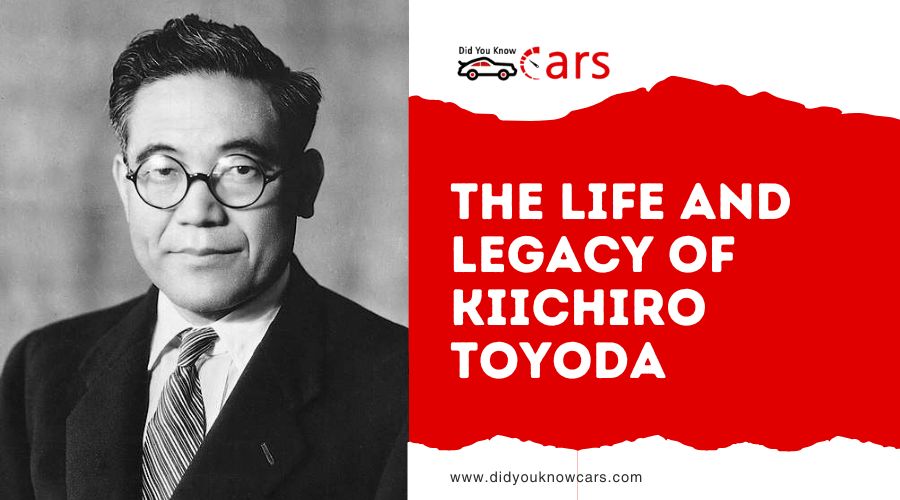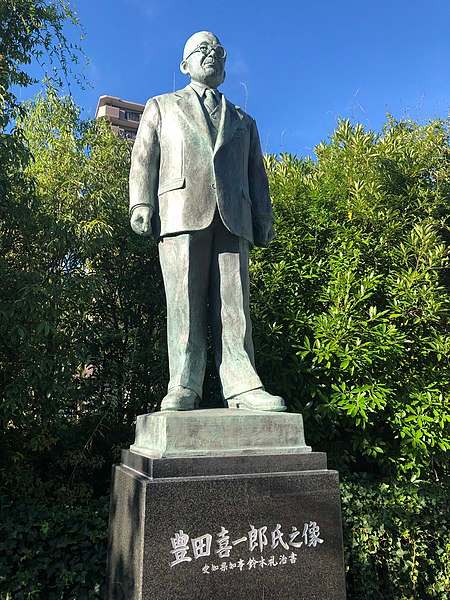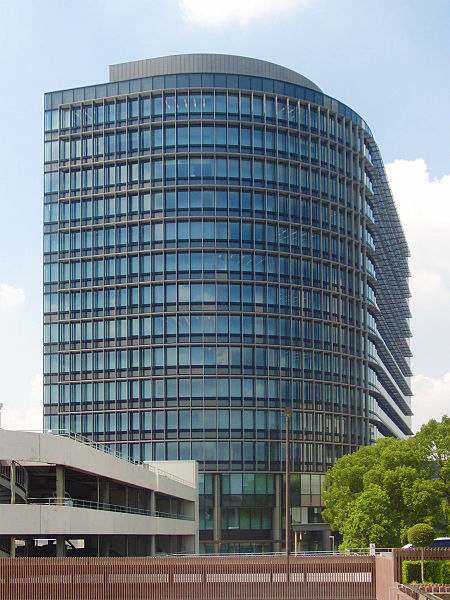Kiichiro Toyoda, a titan in the automobile industry, reshaped the landscape of automotive manufacturing. His innovative spirit and visionary leadership transformed a family business rooted in textile machinery into Toyota Motor Corporation, a name synonymous with quality and efficiency in the global car market.
This blog post explores the journey of Kiichiro Toyoda, from his early influences to his pioneering contributions that revolutionized not just Toyota but the entire automotive industry, leaving a legacy that continues to drive forward today.
Early Life and Influences
Kiichiro Toyoda was born on June 11, 1894, in Shizuoka Prefecture, Japan. He was the eldest son of Sakichi Toyoda, the founder of Toyoda Loom Works. Kiichiro’s early life was significantly influenced by his father’s innovative spirit in the field of textile machinery.
Shortly after his birth, his mother, Tami Sahara, left the family due to her dissatisfaction with Sakichi’s intense focus on his inventions, which she felt came at the expense of family life. As a result, Kiichiro was raised by his grandparents in Yoshitsu village. This event might have had a profound impact on Kiichiro’s upbringing and possibly influenced his later life and career decisions. He later moved to Nagoya with his father and pursued his education, which led him to join the family business and eventually transition it into the automotive giant Toyota Motor Corporation.
Education
Kiichiro Toyoda attended Tokyo Imperial University, where he graduated from the Department of Mechanical Engineering. His time at the university was marked by a strong academic performance, laying a solid foundation for his future endeavors.
After university, Kiichiro joined Toyota Boshoku, a company founded by his father. He then traveled to the United States and Europe to study the spinning and weaving industry, gaining valuable insights and experiences that later influenced his transition to the automotive industry.
After he returned to Japan in 1922, he married Hatako Iida, the daughter of Shinshichi Iida, co-founder of the Takashimaya department store chain.
Founding of Toyota
In the early 1920s, Kiichiro Toyoda foresaw the potential of the automobile industry and directed his efforts toward developing domestic cars. Despite challenges such as the lack of experience in automobile manufacturing in Japan, he persisted. His team dismantled a Chevrolet to study its components, marking a significant step in understanding and developing automotive technology.
Establishing Toyota Motor Corporation
He established Toyota Industries Corporation in 1926 and became its managing director. They established an automobile manufacturing department, later the automobile department, in the newly established company.
In 1936, Toyota was recognized under the Automotive Manufacturing Act, and the following year, it emerged as the independent Toyota Motor Corporation, with Kiichiro Toyoda as vice president. The establishment of Toyota Motor Corporation in 1937 officially marked the company’s entry into the automotive sector.
Transition from Textile to Automotive
Despite challenges like the team’s inexperience and a six-month engine manufacturing process, the first A1 passenger car was ready by May 1935. Soon enough, Toyota Industries Corporation began full-scale automobile production. Kiichiro Toyoda spearheaded the shift of Toyota Industries Corporation, originally focused on loom manufacturing, towards automotive production. This decision was based on his international experiences and his vision of the future of the automotive industry. And boy, was he right about cars!
He streamlined operations, focusing on both mass-produced and specialty cars. Despite facing quality and cost challenges, Kiichiro’s proactive approach and in-house part manufacturing overcame these obstacles, leading to his presidency in 1941.
War and Post-War Challenges
During World War II, the Toyoda family, like many, faced challenges; their business pivoted to truck production for the military, and their personal lives were disrupted, with their children’s education being affected. Despite these hardships, the Toyoda family businesses managed to avoid destruction towards the end of the war.
Toyota was required to manufacture trucks for the military during the war and was not allowed to make passenger cars. Despite these challenges, Kiichiro continued to focus on automotive innovation and development. He negotiated with the authorities and talked about the recovery of the automobile industry, showing his passion for the car and automobile industry.
Reviving Toyota Motor Corporation
After the war, producing and selling cars was still difficult because raw materials and parts became harder to obtain. Kiichiro persevered and focused on research, and when they were allowed to produce passenger cars again, he started to work on production on the day of approval.
Kiichiro focused on reviving Toyota Motor Corporation amidst these challenges. He navigated through material shortages and infrastructural rebuilding, ensuring the company’s survival and growth.
Kiichiro made crucial decisions to adapt Toyota’s production and business strategies to align with the post-war market realities, focusing on producing vehicles that catered to the changing needs of consumers.
Dodge Line Recession
During the 1949 Dodge Line recession, Kiichiro Toyoda faced significant financial challenges at Toyota. To keep the company afloat, he implemented cost-cutting measures, including a reduction in wages, while ensuring no employee layoffs. This approach helped maintain workforce morale and company loyalty during a difficult period.
Additionally, Kiichiro actively sought financial support and negotiated with banks, eventually securing a substantial loan that was crucial for Toyota’s survival and future stability. This way, Toyoda avoided going bankrupt.
Leadership Style and Management Philosophy
Kiichiro Toyoda’s management philosophy was marked by continuous improvement (Kaizen) and lean manufacturing, which involved reducing waste and streamlining processes. He emphasized teamwork, collaboration, and empowerment of employees.
His hands-on approach and regular interactions with the factory floor workers were key aspects of his leadership style. Kiichiro believed in putting the customer first and focusing on quality to ensure long-term success.
Emphasis on Continuous Improvement (Kaizen)
Kiichiro Toyoda was a strong advocate of the Kaizen philosophy, which focuses on continuous improvement in all aspects of an organization. He believed that even small, incremental changes could lead to significant advancements in efficiency and quality.
Lean Manufacturing and Efficiency
Toyoda introduced lean manufacturing to Toyota, a methodology that aims to minimize waste while maximizing productivity. This approach was instrumental in making Toyota’s production processes more efficient and cost-effective.
Innovation and Adaptation
Innovation was at the heart of Toyoda’s leadership. He was constantly seeking new methods and technologies to improve the design and production of cars. This forward-thinking approach kept Toyota at the forefront of the automotive industry.
Empowering Employees
Toyoda believed in empowering his employees, giving them the freedom to take initiative and contribute ideas for improvement. This created a collaborative and dynamic work environment where employees felt valued and invested in the company’s success.
Customer-Centric Approach
Putting the customer first was a key aspect of Toyoda’s philosophy. He believed that understanding and meeting customer needs was crucial for long-term success.
Hands-On Leadership
Toyoda was known for his hands-on approach. He often visited factory floors and interacted with workers, gaining insights into the day-to-day operations and challenges, which helped him make informed decisions.
Focus on Quality
Quality was a cornerstone of Toyoda’s leadership. He ensured that Toyota cars were reliable and durable, which helped build a strong reputation for the brand globally.
Environmental Responsibility
Under Toyoda’s leadership, Toyota also began focusing on sustainability and environmental responsibility, paving the way for future developments in hybrid and electric vehicles.
Retirement and Death
Kiichiro Toyoda retired from his role as president of Toyota Motor Corporation in 1950. His decision to step down was largely influenced by the financial difficulties and labor disputes the company faced during the post-World War II period.
Final Years and Personal Projects
After retiring, Kiichiro focused on personal projects, including designing a small helicopter. He established a laboratory at his home in Tokyo for these endeavors.
Death
Kiichiro Toyoda passed away on March 27, 1952. He died at the age of 57 due to a fall, which was believed to result in a cerebral hemorrhage, a complication of his chronic hypertension.
Legacy and Impact on the Automotive Industry
Kiichiro Toyoda’s contributions had a profound impact on the automotive industry, such as:
Revolutionizing Automotive Manufacturing
Kiichiro Toyoda’s most significant legacy is the establishment of Toyota Motor Corporation and his pioneering role in modernizing Japan’s automotive industry. His vision and initiatives laid the foundation for Toyota to become a global leader in car manufacturing.
Introduction of Lean Manufacturing
Toyoda’s introduction of lean manufacturing and the Toyota Production System revolutionized production processes, not just in automotive manufacturing but across various industries. This system emphasized efficiency, quality control, and waste reduction, setting new standards in manufacturing.
Global Expansion and Impact
Under Kiichiro’s leadership, Toyota expanded globally, significantly impacting the automotive industry worldwide. His strategies and management philosophies influenced how companies approached production, quality control, and employee management.
Pioneering Environmental Responsibility
Kiichiro Toyoda’s foresight in environmental sustainability initiated Toyota’s journey towards developing eco-friendly vehicles, including hybrids and electric cars, positioning Toyota as a leader in sustainable automotive technology.
Conclusion
When we look at Kiichiro Toyoda’s extraordinary life, we’ll see a vivid portrait of a man whose innovative spirit and relentless pursuit of excellence not only birthed Toyota Motor Corporation but also revolutionized the global automotive industry. Kiichiro’s legacy extends far beyond the cars that bear his family’s name; it lives on in the principles of lean manufacturing, continuous improvement, and a relentless focus on quality and efficiency. His story is a testament to the power of vision, leadership, and the enduring impact of one man’s dream to drive the future.



